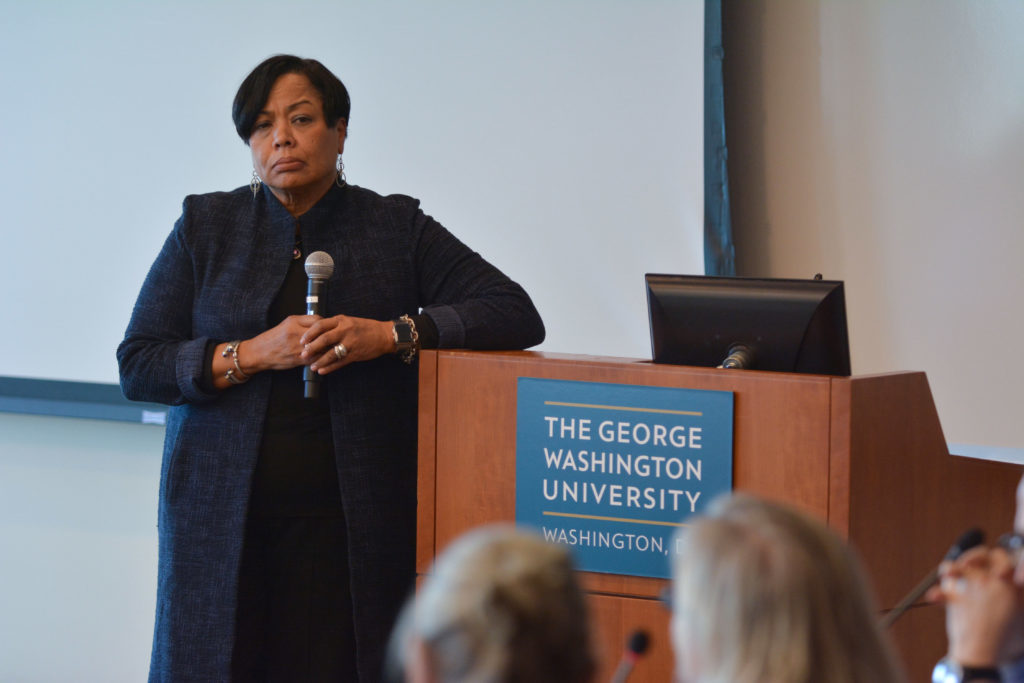Faculty Senate members voiced concerns about a planned undergraduate enrollment cut, the push to boost the STEM ratio and declining rankings at the body’s October meeting Friday.
Grace Speights, the recently appointed chair of the Board of Trustees, gave an introductory presentation at the senate meeting to share what she has been working on since becoming chair, like assisting with the University’s provost search. Faculty questioned Speights and University President Thomas LeBlanc about the University’s goals, including the enrollment decrease and STEM push, and about how the pair plans to implement these goals in the next few years.
Speights said in her presentation that she has met with several members of the community, like Faculty Senate Executive Committee Chair Sylvia Marotta-Walters and Student Association President SJ Matthews, as part of her “many months of in-depth training” after taking the board chair position.
“We have to make decisions that we believe are in the best interest of the University,” Speights said. “That is the role of a governing Board of Trustees. As to how those policies are then implemented, that’s where we include the other constituents of the University.”
Undergraduate population cut
At the meeting, LeBlanc clarified that officials project a cut in revenue of about $64 million over four years resulting from the roughly 20 percent drop in undergraduate enrollment officials plan to implement over the next five years. Arthur Wilson, an associate professor of finance, asked LeBlanc where officials plan to allocate the cuts, but LeBlanc did not address Wilson’s question.
Wilson also voiced an issue on behalf of Philip Wirtz, a professor of decision sciences and psychology, about LeBlanc’s plan to contract the undergraduate population, which he said will reduce the pool of available financial aid. Wirtz, in his statement, asked Speights for the board’s assurance that the enrollment decrease will not cause a return to “the days of old, when GW was known primarily as a rich white kids school.”
Wirtz said in an email that he resigned from his position on the Faculty Senate’s executive committee. He did not return a request for comment about why he resigned.
Faculty have previously raised concerns that an increase in the number of science, technology, engineering and math majors could reduce the amount of scholarship money available for underrepresented minorities.
Speights said diversity will remain “at the top of our list” while officials look to cut the undergraduate population, which was the most diverse in at least a decade last fall.
“It’s even in our framework in terms of the strategic plan, and I, as chair of the board, will tell you that we will not impact diversity as a result,” she said.
Wilson also asked LeBlanc to clarify his definition of STEM as the president seeks to boost undergraduate STEM enrollment to 30 percent of the student body.
LeBlanc said the committee on undergraduate education for the strategic planning process is working to develop a concrete definition of STEM to measure the University’s progress on the target.
“The challenge is if you want to measure yourself precisely, you have to define,” he said. “You have to be specific, and then you have to work to it.”
LeBlanc said there are five “natural” ways to achieve his goal of growing STEM, which include “moderately” growing the number of engineering majors, gradually expanding “basic sciences” in the Columbian College of Arts and Sciences and increasing the number of students double majoring in one non-STEM field and one STEM subject.
He said he expects the members of the committee to make additional recommendations for defining STEM.
“Some combination of those five things, each done in moderation, would easily reach the goal that we’re talking about,” LeBlanc said.
Dip in national rankings
GW dropped seven spots in U.S. News and World Report’s ranking of the best colleges in the country last month. Sarah Wagner, an associate professor of anthropology, said two major causes for GW’s drop according to the news magazine’s methodology are inadequate financial aid for students and a lack of faculty resources.
She said LeBlanc’s plan to reduce undergraduate enrollment and increase the “per-unit cost of education” by increasing the ratio of students who major in STEM could increase GW’s “reliance” on students who can pay the full amount of tuition as the University’s financial aid pool shrinks. Wagner said that change could reduce GW’s socioeconomic diversity and lower its ranking more in the future.
LeBlanc said GW fell in the rankings because U.S. News changed its formula for determining college rankings, not because the University made a change. He said the report now accounts for the percentage of students at an institution eligible for Pell Grants – a subsidy from the federal government to poor students – which naturally skews the rankings toward public universities that tend to enroll more Pell recipients.
“The minute you announce them, you don’t have to do the math,” LeBlanc said. “The minute you announce them, I guarantee you 10 publics are going this way and 10 privates are going this way.”
He added that other areas where the University has traditionally done well, like its “strong” relationships with high school guidance counselors, were not considered at all in this year’s rankings.
LeBlanc said that moving forward, officials will consider whether they should target a specific ranking or instead target underlying factors contributing to the rankings that they consider intrinsically “valuable,” like the six-year graduation rate.
“Part of the discussion needs to be about what are our values,” he said. “What do we care about?”











